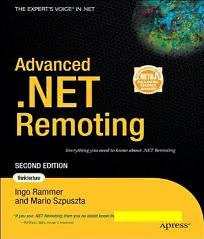Download Advanced .NET Remoting PDF Free - Full Version
Download Advanced .NET Remoting by Ingo Rammer, Mario Szputza in PDF format completely FREE. No registration required, no payment needed. Get instant access to this valuable resource on PDFdrive.to!
About Advanced .NET Remoting
Introduction to .NET remoting, history of distributed computing mechanisms (including DCE/RPC, CORBA, and COM to .NET), advantages of .NET remoting (and architecture), a simple getting started program using .NET remoting with a server and client, adding validation, types of remoting (passing objects by value and reference, singletons, published objects), using factories to create objects, server-activated vs. client-activated objects, lifetime management, synchronous vs. asynchronous function calls, multi-server programming, shared assemblies (and the soapsuds utility and proxies), configuration (XML config. files and standard options), deployment (console vs. Windows services vs. IIS), security issues (authentication and checking roles), using SSL and encryption, object lifetime management (lease time and managers, server-side sponsors), versioning for .NET components (strong naming and the Global Assembly Cache, GAC), delegate and events (tips for event handling), .NET remoting internals (proxies, messages, message sinks, formatters, and transport channels), internals of asynchronous processing, advanced sink programming (client-, server-side, and dynamic sinks), extending .NET remoting (including message compression and encryption support), custom transport channels (using POP3/SMTP), and undocumented techniques for working with .NET remoting context objects. --This text refers to an out of print or unavailable edition of this title.
Detailed Information
| Author: | Ingo Rammer, Mario Szputza |
|---|---|
| Publication Year: | 2005 |
| ISBN: | 1590594177 |
| Pages: | 594 |
| Language: | English |
| File Size: | 15.146 |
| Format: | |
| Price: | FREE |
Safe & Secure Download - No registration required
Why Choose PDFdrive for Your Free Advanced .NET Remoting Download?
- 100% Free: No hidden fees or subscriptions required for one book every day.
- No Registration: Immediate access is available without creating accounts for one book every day.
- Safe and Secure: Clean downloads without malware or viruses
- Multiple Formats: PDF, MOBI, Mpub,... optimized for all devices
- Educational Resource: Supporting knowledge sharing and learning
Frequently Asked Questions
Is it really free to download Advanced .NET Remoting PDF?
Yes, on https://PDFdrive.to you can download Advanced .NET Remoting by Ingo Rammer, Mario Szputza completely free. We don't require any payment, subscription, or registration to access this PDF file. For 3 books every day.
How can I read Advanced .NET Remoting on my mobile device?
After downloading Advanced .NET Remoting PDF, you can open it with any PDF reader app on your phone or tablet. We recommend using Adobe Acrobat Reader, Apple Books, or Google Play Books for the best reading experience.
Is this the full version of Advanced .NET Remoting?
Yes, this is the complete PDF version of Advanced .NET Remoting by Ingo Rammer, Mario Szputza. You will be able to read the entire content as in the printed version without missing any pages.
Is it legal to download Advanced .NET Remoting PDF for free?
https://PDFdrive.to provides links to free educational resources available online. We do not store any files on our servers. Please be aware of copyright laws in your country before downloading.
The materials shared are intended for research, educational, and personal use in accordance with fair use principles.

